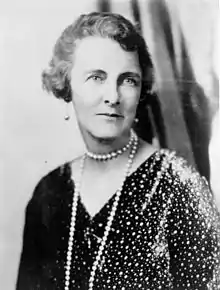Grace Fortescue
Grace Hubbard Fortescue, née Grace Hubbard Bell (November 3, 1883 – June 24, 1979), was a New York City socialite who murdered a man, later proven innocent, who was accused of raping her daughter. After being convicted of manslaughter at a sensational trial, her ten-year sentence was commuted to a single hour by Hawaii's Territorial Governor Lawrence Judd.[1][2]
Grace Fortescue | |
|---|---|
 Grace Fortescue | |
| Born | Grace Hubbard Bell November 3, 1883 |
| Died | June 24, 1979 (aged 95) |
| Citizenship | American |
| Spouse(s) | |
| Children | Thalia Fortescue Massie Marion Fortescue Viskniskki Helene Whitney |
| Parent(s) | Charles J. Bell Roberta Wolcott Hubbard Bell |
| Relatives | Gardiner Greene Hubbard (grandfather) |
Early life
Grace Hubbard Bell was born November 3, 1883, in Washington, D.C. Her father Charles John Bell was first cousin of inventor Alexander Graham Bell. Her mother was Roberta Wolcott Hubbard Bell (1859–1885). Her maternal grandfather Gardiner Hubbard was the first president of Bell Telephone Company.[1] When her mother died in childbirth in 1885, her father married her mother's sister, Grace Hubbard.[1][3]
The family lived at Twin Oaks, their estate in the Cleveland Park neighborhood of Washington, D.C.[4] Newspaper reports indicate that Grace could be classified a prankster: as a youth, she and her friends stole a trolley car for a joy ride through the streets of Washington and, on another occasion, she blocked traffic on Pennsylvania Avenue by joining hands with friends and roller-skating down the avenue.[5]
Personal life
In 1910, she married U.S. Army Major Granville "Rolly" Fortescue (1875–1952), one of the sons of Robert Barnwell Roosevelt. Her husband was first cousin of U.S. President Theodore Roosevelt. The marriage was not as financially successful as she would have wished.[2] She was the mother of three daughters:
- Thalia Fortescue Massie (1911–1963), who married Thomas Hedges Massie (1905–1987), a Navy lieutenant.[4]
- Marion Fortescue (1912–c. 1983), who married Daulton Gillespie Viskniskki in 1934.[4]
- Kenyon Fortescue (1914–1990), better known as actress Helene Whitney; she married J. Louis Reynolds in 1936.[6]
Outwardly, the Fortescues appeared to be wealthy country gentry. In reality, financial affairs became a primary concern for them after Granville's final retirement from the army. With the exception of a short stint as a fiction editor for Liberty magazine in 1930, he did not have steady employment, preferring to wait for the fortune his wife would inherit at the death of her parents.[5]
Murder trial
In 1932, Grace Fortescue was charged with murder and convicted by a jury of manslaughter for the death of Joseph Kahahawai, one of the defendants in the alleged rape of her daughter Thalia in Hawaii in 1931.[7] Also charged and convicted with Fortescue were two sailors, Edward J. Lord and Deacon Jones, and Fortescue's son-in-law, Thomas Massie, who participated in the abduction and murder of Kahahawai.[2]
Attorney Clarence Darrow defended Fortescue, Jones, Massie, and Lord. He subsequently obtained a commutation of their sentence (ten years' imprisonment for manslaughter) to a one-hour confinement in the executive chambers of Territorial Governor Lawrence M. Judd.[2]
In 1966, while being interviewed by author Peter Van Slingerland, Albert O. Jones admitted that he was the one who shot Joseph Kahahawai.[8][9]
References
- "Grace Hubbard Fortescue (1883-1979)". The Island Murder. PBS. Retrieved April 11, 2018.
- "The Island Murder - Transcript". American Experience. PBS. April 2018. Retrieved April 11, 2018.
- "Hubbard Family Tree". Bell Family Papers. US Library of Congress. Retrieved October 14, 2010.
- Judith A. Spinzia; Raymond E. Spinzia (May 8, 2006). "Fortescue, Granville Roland (1875-1952)". Long Island's Prominent Families: Their Estates and Their Country Homes (PDF). I. ISBN 1-58939-785-1.
- Spinzia, Raymond E. (Summer 2006). "Those Other Roosevelts: The Fortescues" (PDF). The Freeholder. Oyster Bay, NY, USA: Oyster Bay Historical Society. 11: 8–9, 16–22. OCLC 52571766. Retrieved 2013-03-01.
- "Milestones". Time. July 27, 1936. Retrieved October 15, 2010.
- David E. Stannard, "Honor Killing", Viking Penguin, 2005 (illustration number 28, entitled Mug Shots and arrest file of Grace Fortescue) ISBN 0-670-03399-5
- Van Slingerland, Peter (1966). Something Terrible Has Happened. New York, NY: Harper and Row. p. 318. ASIN B0007E1F3K. OCLC 1409013.
- Hunt, George P., ed. (1966-10-07). "... A Sailor Confesses to Old Hawaii Killing". Newsfronts. Life. New York, NY: Time Inc. 61 (15): 39. ISSN 0024-3019. OCLC 320514071. Retrieved 2013-10-21.
External links
- Webpage for The American Experience, "The Massie Affair", retrieved on 2008-06-07.
- Stannard, David. "The Massie case: Injustice and courage" The Honolulu Advertiser, October 14, 2001, retrieved on 2008-06-07.
